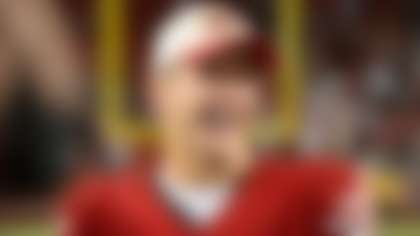NFL.com associate editor Jason Feller sat with Pat Kirwan and Vic Carucci during their "End Zone" show on Sirius Satellite Radio live from the Scouting Combine on Sunday. The following observations were gleaned with help from their conversations with cornerback prospect Aqib Talib of Kansas State and Bill Polian of the Indianapolis Colts.
The running backs and wide receivers worked out on Sunday, bringing a lot of attention to the RCA Dome and the 40-yard dash.
Several players helped their draft stock with strong times in the 40, while a few others may have hurt themselves with slower times.
I will look at a few guys in each position group to determine who appears on the rise and who needs to shine at their Pro Day workout.
Wide receivers
Virginia Tech's Eddie Royal, Florida's Andre Caldwell and Indiana's James Hardy all helped themselves with solid workouts at the combine.
Royal led all wide receivers with 24 bench press reps and posted an impressive 4.39 in the 40-yard dash.
In my mind, he projects to be an ideal slot receiver in the NFL. He does not possess world-class speed, but has a sudden burst and demonstrated an ability to get behind defenders repeatedly at the Senior Bowl.
He showed in Mobile that he has "fooball playing speed" and is a powerful kid with great hips.
The NFL is a copycat league and with Wes Welker's success at New England, many teams are looking for the quick slot receiver who can return punts.
Royal fits into that category perfectly. Virginia Tech puts an emphasis on special teams and in addition to his receiving skills, Royal showed himself to be a dangerous returner.
Kansas cornerback Aqib Talib said that Royal was the toughest cover he faced in college because of his crisp routes and good hands.
Royal came to Indianapolis as a fourth-round type prospect but has potentially moved up to second-round status after his solid workouts.
Caldwell also improved his stock with a fast 40 time. The younger brother of Redskins receiver Reche Caldwell, Andre showed he can run as fast as anyone.
He clocked a 4.37, just barely behind California's DeSean Jackson, to place second among all wide receivers.
The advantage he has over Jackson is his size. Whereas Jackson weighed in at only 169 pounds on a 5-foot-9 frame, Caldwell is closer to 204 pounds and 6-foot. They also each had similar college production. Jackson caught 65 passes for 762 yards and six touchdowns his senior year, while Caldwell had 56 receptions for 761 yards and seven touchdowns.
When given a choice in the draft between players of similar speed and production, teams might be tempted to go with the slightly larger player, that being Caldwell.
He has likely worked his way into first-round consideration.
Differently than the prior two receivers who are each slightly shorter, Indiana's James Hardy comes in at 6-6 and has a basketball background.
With the success of the two Super Bowl teams, each of which featured a tall WR (Giants -- Plaxico Burress, Patriots -- Randy Moss), the demand for size at that position is high.
Hardy reportedly ran a 40 in the range of 4.5 and if that is true, his stock could be rising rapidly.
Tall receivers who have speed do not come along very often, making Hardy a valuable commodity.
On the flip side, Michigan's Mario Manningham did not run exceedingly well in the 40 and his draft position could fall as a result.
Known as a speed guy with an ability to go deep and run reverses, he cannot afford to get labeled as slow.
His production in college being stellar, if he can run great at his Pro Day workout, the combine performance may be minimized.
Running backs
Arkansas' Darren McFadden and Oregon's Jonathan Stewart both pushed themselves to top of a very impressive running back class with fast 40 times. Ten running backs ran sub 4.5 40s and there could be ten backs that are selected in the first two rounds.
On Sunday, however, McFadden and Stewart showed everyone that they are special.
With a 4.33 time in the 40, the second-fastest of any player here, McFadden elevated himself to elite draft status. He is likely a top-5 pick, if not higher.
Let's make athletic talent our only priority in judging prospects. When you do that, you can only arrive at one conclusion: Darren McFadden is the best of the 334 players at the combine. More ...
His production in college combined with his speed make him a potential star.
Stewart, meanwhile, solidified himself as a definite first-round choice. He has compared himself to Jamal Lewis when descibing his style and carries a load at 235 pounds. He is a prototypical power back and will fit in nicely on a team looking to pound the football.
Furthermore, his 4.48 time in the 40 showed that he has the speed to go along with his bulk and strength (28 reps in the bench press). He is an outstanding prospect.
Aside from McFadden and Stewart, Illinois' Rashard Mendenhall also stood out.
He ran a very respectable 4.45 40 and led all running backs in the 20-yard shuttle with a 4.18. This shows that he has quick lateral movement and will be able to make the cut backs so crucial to pro success.
He also demonstrated his strength by doing 26 reps in the bench press.
This could be one of the better running back classes in recent years and each player's ability to pass-block could become a main factor.
Colts general manager Bill Polian said that pass-blocking is critical for running backs in the NFL these days and that the running backs' ability in that area is a key seaparator when evaluating talent.
Similar to Manningham, another Michigan player, Mike Hart, ran a slow 40 and possibly hurt his draft stock.
Hart was tremendously productive in Ann Arbor, but his relative lack of speed and the amount of carries he had with the Wolverines could make him a mid-round selection.
Still, he is the type of player any team would want and Polian said he could be an excellent No. 2 back, if not the main guy.
Like Manningham, Hart could help himself with a strong Pro Day workout.



